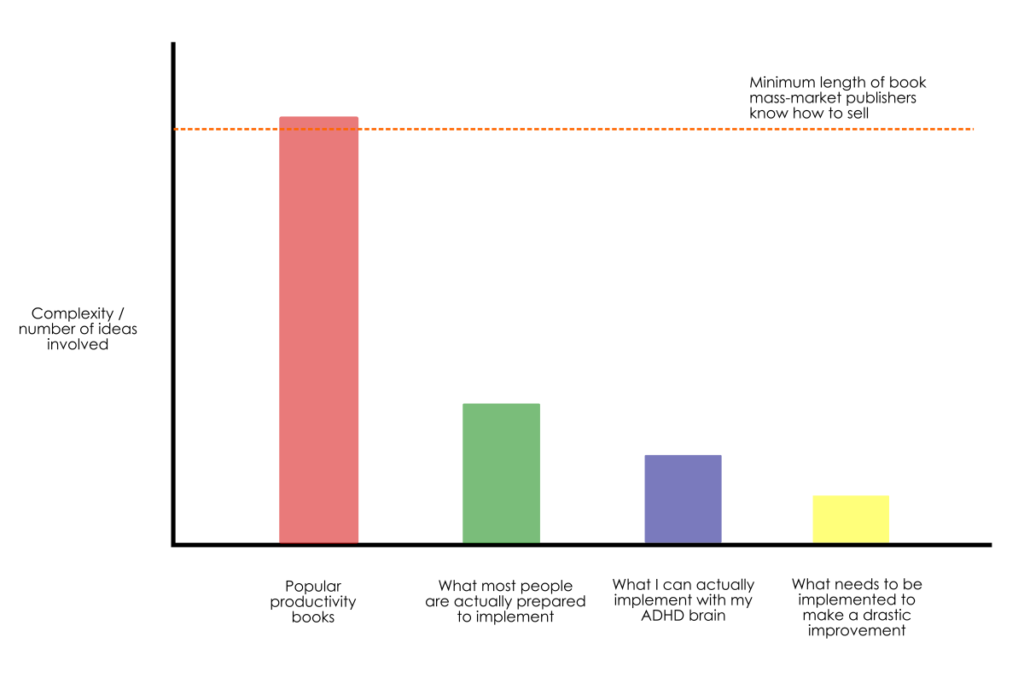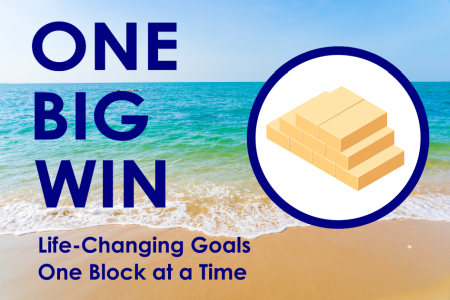
Imagine you’re having a hard day, and you get home to find that someone has left dinner for you. It’s exactly what you wanted. Lasagne! Or maybe green curry, or tacos.
What good fortune. Some thoughtful person predicted that you might want a meal right right about now, and made sure you had one.
Of course, this thoughtful benefactor could be you, just earlier. Last night, your past self recognized the value a ready-made meal would have for tomorrow’s after-work self, so he left one for you in the fridge.
Now imagine that your past self didn’t only prepare a meal for you last night, but wrote a book a few years ago. Not only do you have dinner waiting for you, but you also receive royalty payments, enjoy increased clout in your industry, and have the skills and confidence to write more books. You’ve inherited much more than dinner from your forward-thinking past self.
Perhaps your past self earned a degree or certification, which got you the job that elevated you beyond paycheck-to-paycheck existence. Maybe she figured out WordPress one weekend, and started a restaurant review site that now has thousands of followers. Maybe she finally read T.S. Eliot’s poems after thinking about it for years, and it precipitated your first genuine spiritual connection with ordinary life, which you’ve felt all of your days since. Maybe she did all of those things.
It’s good to be the downstream beneficiary of these sorts of efforts — small or large personal wins that improve your life situation in lasting and layered ways. You could even say that a good life is one in which you’re frequently grateful for what your past self has left for you.
This sort of inheritance represents real wealth — consisting of personal freedom, money, resources, skills, relationships, and overall well-being — and you can pass it on to yourself.
The Catch
The catch is that achieving these personal wins, and leaving a rich inheritance for yourself all the way though life, depends on your ability and willingness to do things.
Doing, generally speaking, is an extremely useful ability, if you focus on doing things that generate lasting rewards. Can you fix something that’s broken? Can you learn a skill that makes every day easier? Can you build something new in your life? Can you resolve a situation that’s been dragging you down?
Will you though?
Natural ability to do things varies. In a post a few years ago I distinguished between people who seem naturally inclined to do and accomplish — “natural doers” — and those of us who really have to prod ourselves to do things, a group we can call “the productivity-challenged.”
I had noticed, throughout my lifelong quest to become a more of a doer, that productivity advice tends to come from self-starting natural doers, in the form of elaborate multi-habit systems detailed in 250-page books:

As many of you know, my response was to tip all these trends upside down and write a 30-page book, from the perspective of a not-naturally-productive person, about how to get things done despite having no natural talent for doing.
Its goals for the productivity-challenged reader were to:
- Dramatically increase your personal productivity
- Create this increase in a week or less
- Provide the method in a resource you can read in one sitting and implement today
I called this little book How to Do Things and it was the most popular thing I’ve ever released. The gist is to work in uncompromising 25-minute sprints, as is often advised, and to refine that one specific skill, while avoiding any distracting systems of lists, notes, and folders around the doing. You don’t want your ability to do to be chained to a bunch of interdependent, hard-to-form habits.
As I said at the time, productivity-challenged people don’t want ten chapters of methodology they then have to recall, implement, and carefully maintain. They want a hammer put into their hand.
The hammer I gave people — the simple, self-contained, all-purpose tool for doing — is called the “Block method.”
Making a single “Block” — a short, timed session of uninterrupted work towards a particular outcome — is always easy enough, but represents enough meaningful work to move any project forward at least one significant step. Once you know how to make them, Blocks become a kind of “effort currency” with which you can buy (or rather, build) lasting improvements to your life.
- Fixing the wobbly faucet in the kitchen might require one single Block. In less than half an hour you’ve earned a significant inheritance: a smoother, more pleasant kitchen experience every single day, for years at least.
- Setting up a budgeting app, such as You Need a Budget, might take 6 or 7 Blocks. Upon completion, you inherit lower baseline stress levels, a greater sense of control over your life, and enough waste might be prevented to effectively give yourself a raise.
- Completing your first short story might take 24 Blocks. Aside from the completed story, you’ve inherited a new identity, crossing over from a dabbler/dreamer to a real writer with finished work to point to, and the confidence to produce more.
Decluttering the whole house, Marie Kondo style, might take 42 Blocks. Learning the basics of coding in Python might take 80. Setting up a freelance business with a website and social media strategy, plus finding your first three clients, might take 175 Blocks. You can imagine what you might inherit from any of those personal wins, if you could create them.
This is why they’re called Blocks. They are a block of time, yes, but they’re also building materials. You stack them together to build rewarding things in your life.
You can build almost anything you want this way, because:
- Blocks are small enough that they’re always pretty easy to make.
- All goals require a finite number of Blocks.
This modular way to consider goals removes so much trepidation. A major win in your life is no longer at the end of “a journey of a thousand steps.” It’s a journey of nine or fourteen or fifty-five Blocks. It’s a staircase, not an ocean to be crossed.
Choose Your Fortune
I’ve been working on the follow-up to How to Do Things. It’s a course in which we do exactly what I described above.
You choose a goal that would be a major win in your life, perhaps something you’ve been meaning to do for a long time. It should be something that improves your life in the long term, such as:
- Finish your university thesis, or a big section of it
- Assemble your family tree
- Get your novel started, outlined, and two chapters finished
- Deal with your storage locker — clean it out, quit paying the fee, and sell what you don’t want
- Prepare your will
- Renovate some part of your home
- Learn the 10 essential home chef skills and test them with a dinner party
- Declutter every room in the house
- Read a great work of literature, or several of them: The Lord of the Rings, Ulysses, Gone With the Wind, Moby-Dick, some or all of the Bible
- Learn to code
- Gain a foundational understanding of a complex topic: wine, Japanese history, macroeconomics, chess strategy
- Assemble a family cookbook and get it printed
- Learn Adobe Photoshop or some other software application
- Learn to draw, working through a book like Drawing on the Right Side of the Brain
- Start a YouTube channel and post your first three videos
We will each select one of these major personal wins, and make it happen, Block by Block, over an eight-week period.
The program will allow you to hammer out a 25- to 100-Block goal in a relatively short time. The eight weeks will go by quickly anyway, and you will or will not have left yourself a major inheritance by the end of it.
The working title for this course is One Big Win. By making the goal modular and adopting a community-reinforced timeframe, you can get one of your major goals behind you and begin enjoying its proceeds.
One Big Win is designed so that you only have to focus on the next Block, which never takes more than half an hour. There’s no need to “clear the decks” beforehand, or take time off. You add a Block or two to the stack whenever you can.
More details and a full FAQ will come later, but I’ll clarify one thing now: you don’t need to know how to achieve your goal before beginning. Finding and selecting methods is part of the course (and a necessary part of every goal) and some of your first Blocks will go toward that. I can’t teach you how to write a screenplay, but I can teach you how to find out and make a plan in minimal time.
UPDATE [Nov 2023]: One Big Win is open for registration! [More info here]
So often, we don’t take on projects we know would benefit us because we don’t know what they entail. Looking at them through the Block method lens, you know what basically all goals entail: some number of Blocks. Once you’ve made a few Blocks, you know you can always make another, and if you can make another, you can make ten or twenty or a hundred, and already we’re talking about some pretty big fortunes.
***
Photos by Ashin Suresh, Mateusz Feliksik, Emmanuel Ikwuegbu, Torsten Dederichs, Lucas dix sept, Paul Matheson







 I'm David, and Raptitude is a blog about getting better at being human -- things we can do to improve our lives today.
I'm David, and Raptitude is a blog about getting better at being human -- things we can do to improve our lives today.
What you say about blocks being the effort currency makes so much sense ! thank you !
It really broke something open for me. When I consider a goal, my brain immediately starts examining the whole huge things and finds reasons I can’t do it or parts that will hang me up. The Block method converts everything into potential stacks of Blocks. I know I can do a thing that takes 80 Blocks, because I know I can do a Block.
you are a hero ! good work … congratulations
thanks
albert
I’ve been working on cleaning out closets in my house for many weeks. And I love the block idea, I’m trying to take on too much at one time. I go to bed early every night, because sleep is my best friend. I don’t have to deal with the things that have happened over the last three years. So next week, I will start the blocks and stay up an extra 30 minutes at night and get started.
I always enjoy reading your stories.
That is my tendency too — to take on the “whole” thing at once, at least mentally, which usually means I peg it for ‘later’ in my mind, because I seldom have time to take on even something like cleaning out a closet. But you can always do one Block of the closet-cleaning. Then maybe it takes 3-4 more, but it never seems like it’s too big to do right now.
@Theresa Walden, you MIGHT find you don’t need to stay up longer if you apply the block theory to a few of your daily tasks. When I am on-block-task mode, I get SO much more done, and faster. If you have some daily things that you just MIGHT be procrastinating on, you could find that using the block method will get them done faster, freeing up a block’s worth of time within your usual day for your new goal!
Buying How to Do Things has been in my to-do list for a while. Thanks for the nudge, I finally checked it off.
I am obviously biased, but I believe that particular to-do will provide a worthwhile and lasting inheritance
Howdy David!
I am 68 years old and I’ve been playing music since I was four. I think my musical development breaks down into a fair number of blocks. Block by block I’ve built a beautiful “inheritance”
which continues to grow and pay dividends daily. I have been fortunate to be a self starter. Not everyone is blessed with that trait. I know many people who are stuck in the mud. I think your next book will provide a solid method to get folks rolling.
Very fine of you….
NOW GET BACK TO WORK!!!!!
Music is a great application for this. One of the coolest parts of this for me, being a numbers nerd, is finding out how many Blocks certain things actually end up taking. If you wanted to play the guitar solo from Stairway to Heaven with no mistakes, how many Blocks of practice will it take from where you are? 9? 35? Once you find out, you can more easily determine how far you are from knocking off similar goals.
Ever since reading David’s brilliant book I’ve been excited for a course like this; so excited, in fact, I’ve just completed 3 blocks!
How is this different from GTD (Getting Things Done) – David Allen? Thank you
Getting Things Done is a complex system for organizing all of your concerns and to-do’s into a watertight system of lists, folders, and calendars, so that you don’t overlook anything. It’s geared towards people who already get a lot done. I think it’s pretty great but it’s a lot of work just to implement it, and maintaining it requires you to establish a number of new habits simultaneously.
It also doesn’t help you do anything, it just helps you organize things you have to do. It assumes you know how to get a lot done.
How to Do Things offers a simple method for getting a lot done, regardless of how you organize your to-do lists, calendars, etc. It focuses on the *doing* — how to get into and move through the task and get it done efficiently.
The two books would make a good compliment to each other: HTDT for doing, GTD for organizing things to be done.
This course sounds like a great idea, David!
David, can you clarify if the course offers new information that is not in your book?
Yes, it does. The Block method is an essential tool for doing the course but the course itself focuses on getting your arms around a larger goal so that it can be planned, begun and worked through in a finite timeframe using Blocks. I will send out details and a full FAQ later.
David, will the book still be on sale on September 1? I seem to have spent my allotted “Wants” budget for August. If the sale ends in August, I could of course justify it as a “Need”. :)
Yes will still be on sale Sept 1 for sure.
I am so looking forward to taking this course! Your book was super helpful and for a long time I applied the block method. But things got off track in life and the block method fell away. I’m in desperate need to get back to doing things and so I’ve started using the block method again. But what you’ve said about the course: “By making the goal modular and adopting a community-reinforced timeframe, you can get one of your major goals behind you and begin enjoying its proceeds.”…that’s what I really need: the community-reinforced timeframe. Thanks!
That happens to me too — I get away from the method. It always works but there are times when I feel like I’m doing “well enough” without the minor formality of Blocks. Then it becomes obvious that I’m really not getting things done like I could be.
The course sounds great. Can’t wait to hear more about it!
hi. Is the course available already or is there a place i should check for information? It sounds super useful and if possible i would like to join.
Still developing it. When it’s open I will announce it in ways that are impossible to miss if you subscribe to the blog :)
The block concept seems useful for me, a master procrastinator.
Comments on this entry are closed.